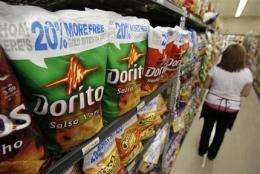Meltdown 101: Package sizes at the grocery store

(AP) -- Your eyes are not deceiving you in the grocery store. Yes, your bag of Doritos just got bigger. No, the price didn't change.
Last year, food packages shrank as food makers, dealing with record high ingredient costs, struggled to maintain their profits. But the weakened economy has caused a slump in demand for ingredients like corn and oil, pushing those prices back down. With lower ingredient costs - and higher consumer demand for more value - some brands like Frito-Lay are shifting back to bigger packages, without raising prices.
Think of your food packages like an economic barometer: Times are tough, so costs are low and packages are bigger. When times are good, costs are high and packages, to compensate, get smaller.
Tough times also mean consumers have less money to spend, so they want those bigger packages. Experts say this is a promotional tool that helps branded food companies steer shoppers back to their products and away from less expensive, store-brand alternatives.
Here are some questions and answers about the changing size of food packages.
Q: What's getting bigger?
A: So far, the most evident size boosting is in the chip aisle, where Frito-Lay dominates. The company has boosted some package sizes for brands like Doritos, Cheetos, Tostitos and Fritos by 20 percent, reversing cuts made to bag sizes last year. Bags on shelves feature a thick white stripe announcing this - the one on Tostitos says: "Hey! There's 20 percent more free fun to share in here!"
Certain Doritos flavors have gone from 12 ounces back to 14.5 ounces, while Fritos bags are now 17.5 ounces, up from 14.5 ounces, and Cheetos are 10.25 ounces, up from 8.5 ounces. Tostitos are now 15.625 ounces, from 13 ounces. The pricing was unchanged, ranging from $2.89 to $3.99.
The company, a subsidiary of PepsiCo Inc., wants to return value to consumers, spokesman Chris Kuechenmeister said. He said Frito-Lay was unsure if these changes, originally taken about six months ago, would be permanent.
Elsewhere in the chip aisle, The Snack Factory increased the size of some of its pretzel crisps line by 25 percent, to 7.5 ounces from 6 ounces, earlier this summer. The promotion should last through the summer, said marketing director Milt Weinstock.
The company raised prices but did not shrink packages when ingredient costs got high, he said. Now that costs have moderated, the company wanted to give customers more for their money and entice new sales.
Offering more for the same price is one way to boost sales since consumers are so focused on saving money right now, said Christopher Shanahan, a research analyst with Frost & Sullivan. Food companies can play up their value to consumers by offering larger-sized packages, which cost less on a per-ounce basis, he said.
Experts say offering larger sizes - along with other methods, like coupons or buy-one-get-one-free promotions - can convince shoppers who are trying to save money to stick with name brands.
Q: What's been happening with food packages and pricing in recent years?
A: Packages had been shrinking and prices had been rising - all in response to soaring ingredient costs. Food companies had higher expenses for key commodities used in production - like corn that goes into chips and fuel used to transport goods from place to place. So they raised prices and shrunk products - everything from cereal to ice cream to canned tuna.
Q: Why are companies making products bigger again?
A: Two reasons: Because they can, and because consumers want it.
Prices for ingredients have moderated from record highs last year. So it costs these companies less to make your food, and they can afford to give you more product for the same price.
It doesn't cost too much extra for them since these products are produced in mass quantities. And it's considered a good investment, since it boosts the amount they're selling and can increase their market share - two things investors like.
Consumers are also asking for it as they look to save money.
Offering more for the same price is one way brands can promote themselves as they compete with store-brand alternatives, which cost less and are gaining sales in some categories at the expense of branded products.
Increasing package sizes also keeps pricing and sales volume steady so revenue doesn't suffer, as can happen from other promotions - like coupons.
Q: Why not just cut the prices? I'd rather save money than get more chips.
A: It's not that simple, pricing experts say. Once prices are lowered, it becomes very difficult to raise them, since consumers may react negatively to that.
Instead, companies can give people more for the same amount of money, making for a per-ounce price cut, but leaving prices unchanged. That means food makers protect their pricing for the future, so they can react when commodity prices go back up - something experts agree will happen as the economy recovers.
In other words: When good times return, don't be surprised if that bag of chips gets smaller again.
©2009 The Associated Press. All rights reserved. This material may not be published, broadcast, rewritten or redistributed.
















